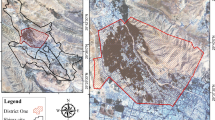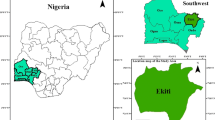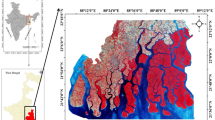Abstract
This research presents the methodology of map** a situation of the natural-landscape resources of Khuzestan province in Iran using time-varying space data according to seasonal changes of the indicators of SAVI and LST. The novelty of this research is the combined use of GIS techniques, optical and thermal remote sensing for map** the situation of the natural-landscape resources aimed at territorial planning. In this research, a classification was carried out for the study area based on the potential of the natural-landscape resources. The Landsat 7 and 8 materials from the periods of 2011–2013 and 2017–2019 were used to perform this research using ERDAS Imagine, ENVI, ArcGIS, and Priznak software. Variations of LST and SAVI were analyzed for 10 seasons of year from April to September. The results showed that both increasing the area of bare soils (wasteland) and residential areas and decreasing the extent of the water resources, forests, and rangeland in Khuzestan province have caused the surface temperature to rise over a period of 9 years. Whereas, matching of the Entisols and Inceptisols with areas having high natural resource potential in Khuzestan province was indicated by the results of this study. And also, the Badlands, Rock-outcrops, and Dunelands are the areas with low natural resource potential. It has been shown that integral indicator of the situation of the natural-landscape resources that calculated using the materials of multispectral space imagery is a stable indicator and criterion for land assessing in terms of their suitability for agricultural use. The results of this study can be used to provide a territorial management and planning in accordance with the goals of land use planning and sustainable development, by potential assessment and map** a status of the natural-landscape resources.








Similar content being viewed by others
References
Aboelghar, M., Arafat, S., Saleh, A., Naeem, S., Shirbeny, M., & Belal, A. (2010). Retrieving leaf area index from SPOT4 satellite data. Egyptian Journal of Remote Sensing and Space Science, 13, 121–127.
Appiah, D. O., Schröder, D., Forkuo, E. K., & Bugri, J. T. (2015). Application of geo-information techniques in land use and land cover change analysis in a Peri-Urban District of Ghana. ISPRS International Journal of Geo-Information, 4, 1265–1289.
Boori, M. S., Vozenilek, V., & Choudhary, K. (2015). Land use/cover disturbance due to tourism in Jeseníky Mountain, Czech Republic: A remote sensing and GIS based approach. Egyptian Journal of Remote Sensing and Space Science, 18(1), 17–26.
Cabral, A. I. R., Silva, S., Silva, P. C., Vanneschi, L., & Vasconcelos, M. J. (2018). Burned area estimations derived from Landsat ETM+ and OLI data: Comparing genetic programming with maximum likelihood and classification and regression trees. ISPRS Journal of Photogrammetry and Remote Sensing, 142, 94–105.
Carlson, T. N., Gillies, R. R., & Perry, E. M. (1994). A method to make use of thermal infrared temperature and NDVI measurements to infer surface water content and fractional vegetation cover. Remote Sensing Reviews, 9, 161–173.
Dutta, D., Arnab, K., Patel, N. R., Saha, S. K., & Siddiqui, A. R. (2015). Assessment of agricultural drought in Rajasthan (India) using remote sensing derived vegetation condition index (VCI) and standardized precipitation index (SPI). Egyptian Journal of Remote Sensing and Space Science, 18, 53–63.
Ferrelli, F., Huamantinco Cisneros, M. A., Delgado, A. L., & Piccolo, M. C. (2018). Spatial and temporal analysis of the LST-NDVI relationship for the study of land cover changes and their contribution to urban planning in Monte Hermoso, Argentina. Documents d’Anàlisi Geogràfica, 64/1, 25–47.
Hopfner, C., & Scherer, D. (2011). Analysis of vegetation and land cover dynamics in North-Western Morocco during the last decade using MODIS NDVI time series data. Biogeosciences., 8(3359–3373), 2011.
**, S. D., Wang, K., Yang, H., & Jia, G. Q. (2009). Spatio-temporal dynamics and evolution of land use change and landscape pattern in response to rapid urbanization. Landscape and Urban Planning, 92, 187–198.
Juan, C., Jimenez-Munoz, J., Sobrino, A., Skokovic, D., Mattar, C., & Cristobal, J. (2014). Land surface temperature retrieval methods from Landsat-8 thermal infrared sensor data. IEEE Geoscience and Remote Sensing Letters, 11(10).
Julien, Y., Sobrino, J. A., Mattar, C., Ana Ruescas, B., Jimenez-Munoz, J. C., Soria, G., Hidalgo, V., Atitar, M., Franch, B., & Cuenca, J. (2011, 2057–2068). Temporal analysis of normalized difference vegetation index (NDVI) and land surface temperature (LST) parameters to detect changes in the Iberian land cover between 1981 and 2001. International Journal of Remote Sensing, 32(7) 10.
Kerr, Y. H., Lagouarde, J. P., Nerry, F., & Ottlé, C. (2000). Land surface temperature retrieval techniques and applications: Case of the AVHRR. In D. A. Quattrochi & J. C. Luvall (Eds.), Thermal remote sensing in land surface processes (pp. 33–109). Boca Raton: CRC Press.
Khosravi H., Haydari E., Shekoohizadegan S., Zareie S. (2016). Assessment the effect of drought on vegetation in desert area using Landsat data. The Egyptian journal of remote sensing and space sciences. Xxx (2016) xxx–xxx.
Lambin, F. F., & Ehrlich, D. (1996). The surface temperature–vegetation index space for land use and land cover change analysis. International Journal of Remote Sensing, 17, 463–487.
Li, Z.-L., Tang, B.-H., Hua, W., Ren, H., Yan, G., Wan, Z., Trigo, I. F., & Sobrino, J. A. (2013). Satellite-derived land surface temperature: Current status and perspectives. Remote Sensing of Environment, 131, 14–37.
Mondal, S., Jeganathan, C., Sinha, N. K., Rajan, H., Roy, T., & Kumar, P. (2014). Extracting seasonal crop** patterns using multitemporal vegetation indices from IRS LISS-III data in Muzaffarpur District of Bihar, India, Egypt. The Egyptian Journal of Remote Sensing and Space Scienc, 17, 123–134.
Rajeshwari, A., & Mani, N. D. (2014). Estimation of land surface temperature of Dindigul district using Landsat 8 data. International Journal of Research in Engineering and Technology., 03(05), 122–126.
Tabatabaiefar A., Nadrlu L., Javadikia P., Shirkuvand H. (2008). Conservation tillage systems and the product growing. Collegiate Jihad of Isfahan University of Technology. P. 12.
Zareie S., Khosravi H., Nasiri A., Dastorani M. (2016). Using Landsat thematic mapper (TM) sensor to detect change in land surface temperature in relation to land use change in Yazd, Iran. Solid Earth. № 7, pp. 1551–1564.
Zareie, S., Rangzan, K., Khosravi, H., & Sherbakov, V. M. (2018). Comparison of split window algorithms to derive land surface temperature from satellite TIRS data. Arabian Journal of Geosciences, 11, 391.
Acknowledgments
The authors are grateful to the United States Geological Survey (USGS) for providing satellite data.
Author information
Authors and Affiliations
Corresponding author
Additional information
Publisher’s note
Springer Nature remains neutral with regard to jurisdictional claims in published maps and institutional affiliations.
Rights and permissions
About this article
Cite this article
Sajad, Z., Mostafa, K. The natural resources potential assessing aimed at territorial planning using time-varying space data of vegetation index and LST. Environ Monit Assess 192, 503 (2020). https://doi.org/10.1007/s10661-020-08476-y
Received:
Accepted:
Published:
DOI: https://doi.org/10.1007/s10661-020-08476-y




